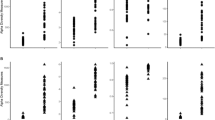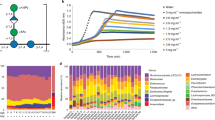Abstract
BOTH the rumen in ruminant and the cæcum in non-ruminant Herbivora support an abundant iodophile microflora: that is, an association of taxonomically diverse species exhibiting, in consequence of the deposition within them of bacterial starch or granulose, the common characteristic of giving a blue reaction with iodine.
This is a preview of subscription content, access via your institution
Access options
Subscribe to this journal
Receive 51 print issues and online access
$199.00 per year
only $3.90 per issue
Buy this article
- Purchase on Springer Link
- Instant access to full article PDF
Prices may be subject to local taxes which are calculated during checkout
Similar content being viewed by others
References
Baker, F., and Martin, R., NATURE, 141, 877 (1938).
Baker, F., Sci. Prog., No. 134 (Oct., 1939).
Baker, F., NATURE, 149, 220 (1942).
Baker, F., and Martin, R., Zent. Bakt., Ab. II, 96, 18 (1937).
Baker, F., and Martin, R., Zent. Bakt., Ab. II, 97, 201 (1937).
Baker, F., and Martin, R., Zent. Bakt., Ab. II, 99, 400 (1939).
Westphal, A., Zent. Parasitenk., 7, 71 (1934).
Owen, E. C., Smith, J. A. B., and Wright, N. C., NATURE, 147, 710 (1941).
Author information
Authors and Affiliations
Rights and permissions
About this article
Cite this article
BAKER, F. Microbial Synthesis and Autolysis in the Digestive Tract of Herbivora. Nature 149, 582–583 (1942). https://doi.org/10.1038/149582a0
Issue Date:
DOI: https://doi.org/10.1038/149582a0
This article is cited by
-
Celluloseabbauende Mikroorganismen
Zeitschrift für Hygiene und Infektionskrankheiten (1952)
-
Der Abbau der Zellulose durch Mikroorganismen
�sterreichische Botanische Zeitschrift (1949)
-
The Rumen Process as a Functional Field: an Attempt at Synthesis
Nature (1946)
-
Phagocytosis in the Appendix of the Rabbit
Nature (1943)
-
MICROBIAL FACTORS IN THE DIGESTIVE ASSIMILATION OF STARCH AND CELLULOSE IN HERBIVORA
Nature (1942)
Comments
By submitting a comment you agree to abide by our Terms and Community Guidelines. If you find something abusive or that does not comply with our terms or guidelines please flag it as inappropriate.



